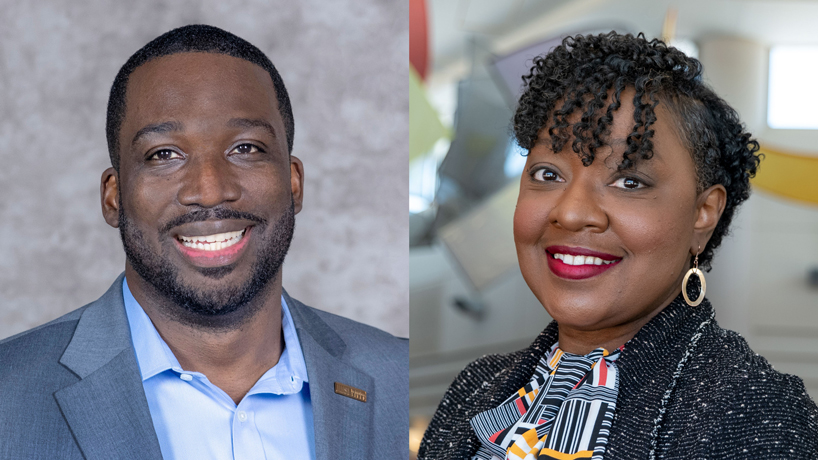
Reggie Hill (at left), vice chancellor for strategic enrollment, and Natissia Small (at right), vice provost for access, academic support and workforce integration, joined host Carol Daniel on “Total Information AM” to talk about challenges in college recruitment. (Photos by August Jennewein)
Competition for students in higher education has increased significantly over the past two decades amid demographic shifts, forcing colleges and universities to be proactive and creative to attract new students.
Reggie Hill, the vice chancellor for strategic enrollment at the University of Missouri–St. Louis, and Natissia Small, UMSL’s vice provost for access, academic support and workforce integration, joined “Total Information AM” host Carol Daniel last week on KMOX (1120 AM) to talk about the changes and how they’re navigating them to keep the St. Louis region’s premier public university strong.
“Fifteen or 20 years ago, we applied to three universities, and we typically picked the university that was closer to home,” Hill said. “It was more than likely that you went to a state public institution. Now that’s not the case, right? Students are choosing between six to seven institutions. More competitive institutions are competing with scholarship dollars to attract students into their institution.”
Hill and Small have tried to foster collaborative partnerships to help recruit new students at a time when the population of the St. Louis region and Missouri more broadly has seen slower growth than many other parts of the United States.
Among the steps taken, UMSL has launched partnerships with industry partners including Amazon and Generation USA and Verizon to meet industry needs and provide educational opportunities to company employees.
“We are making sure that we are building those different pathways for students to have entry into higher ed or into their field of choice,” Small said. “Certificate programs and stackable credentials, that opens up the door to change your family’s life, but to allow them and to encourage them to continue to pursue their education and complete their bachelor’s degree will be a difference. It will be a life-changing difference in their income. That’s social mobility in itself.”
She added: “We have to be creative with our corporate partners, understanding their needs, but also making sure that we’re supporting them so that they can create a culture within their own corporations that will allow an employee to begin to thrive, no matter what level they’re entering from.”
Hill has also established a partnership with the Ministry of Education in the Bahamas that has helped bring approximately 20 students to campus this semester.
UMSL overall saw about a 10% increase in the size of its incoming class this semester with gains in both first-time freshman and transfer students. It will look to continue both trends.
“We have to figure out how to import more students into St. Louis, who will graduate from our institution or institutions and also live, work and grow families here,” Hill said. “That’s how we contribute to the revitalization of the city.”
UMSL’s precollegiate programs, particularly the Bridge Program with its Saturday Academy and Summer Academy, continue to serve as a gateway for area high school students into higher education with many of them choosing to pursue degrees at UMSL. Small talked about how that program has developed to serve more than 4,000 students and families each year.
“They said we need for someone to help develop our students and prepare them for college, so that meant developing a curriculum that touches on those areas that will help support students to be successful with ACT exams, SATs exams, but also impact the likelihood for them to be successful in high school, which undoubtedly means that they have a better opportunity to be admitted into an institution,” Small said. “Then, the professional development piece is always going to be key and understanding that we need to create that pathway and put professionals in front of our students to have those true conversations, to start that networking, and then provide students with that access to information that they don’t traditionally have in a school setting.”
To listen to the full conversation between Hill, Small and Daniel, download the “Total Information AM” podcast.














